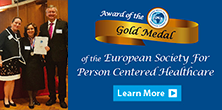October 12, 2019 in
Uncategorized |
∞
November. It’s the one month of the year that seems dreary. The days are shorter. The leaves have fallen and the grass is brown. And the cold wind and rain seem to blow right through you. It’s time to cozy up!
Pull out the soft blankets and candles (battery-operated candles are fine). If you have a fireplace consider yourself lucky and use it! Some call this Hygge which is the Danish word describing a feeling or mood of coziness and contentment. It is a lifestyle, not just an evening/weekend/seasonal thing.
And while updating your home is one way to enjoy the month, getting out of your home and being active and around family and friends is also part of Hygge and is important to avoid becoming isolated.
There are so many opportunities to attend interesting events that it’s easier than ever to stay connected, even during the nasty weather. Pop in to your local library to see what programs they have. Guaranteed they have a knitting and crochet group, a puzzle or adult colouring program or perhaps a book club or authors talk is more your style.
At Mosaic, our Community Resource Centres offer a number of programs that are open to the community to attend. We have a drop-in knitting and crochet group that meets weekly and the participants work on their own projects or help with charity knitting. This year, the group is working on hats and scarves for the Out of the Cold program. It is amazing what a small group of people can do to remember those in our community that may be struggling to make ends meet this season.
If knitting isn’t your “thing”, come out to a Mosaic Community Table Talk! Held in various locations for anyone to attend, join us for interesting discussions. The coffee is on us!
Every year on November 11th, we take time to remember soldiers who fought in wars past, as well as current soldiers and those training for the future to keep our world safe. We invite you to attend a Remembrance Day Ceremony at The Shops on Steeles at 404 at 10:30am on November 11th, 2019.
Hygge, knitting for charity, Community Table Talks and Remembrance Day ceremonies are all ways to get involved in your community. You can also stay involved by helping the people closest to you. Perhaps offer to do some yard work for someone who is not able to do it themselves. Offer to pick up some groceries or simply call someone you haven’t spoken to in a while. These are all ways of remembering people in our lives who may not be family, but are somehow connected to us. We refer to this as being a part of a Compassionate Community.
Should you find that a neighbour, friend or family member requires more support, whether this be cooking, cleaning or personal support, Mosaic Home Care is just a call away.
For information on our programs and services visit us at www.mosaichomecare.com or call 416.322.7002 or 905.597.7000.
You don’t need to be a musician to benefit from music therapy.
My name is Dorothy Davies and I am an accredited music therapist with advanced training in Neurologic Music Therapy. In this article, I will be answering some common questions related to music therapy, including:
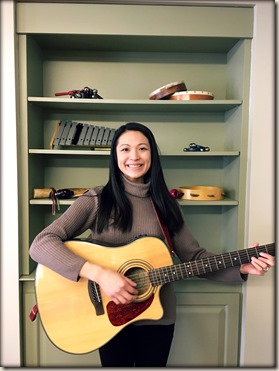
● Do I have to know how to sing or play an instrument?
● Is music therapy the same as music education or performance?
● What is music therapy?
● Who is it for?
● What areas can be addressed?
Do I have to know how to sing or play an instrument?
No, the focus of music therapy is not on musical skills or expertise. Rather, music is used as the primary tool in order to address clinical, non-musical goals.
Is music therapy the same as music education or performance?
No, music education (lessons) focus on the development of musical skills, techniques, and expertise. Music performance focuses on the implementation of those skills for entertainment purposes.
What is music therapy?
Music therapy is a therapeutic service provided by an accredited music therapist (MTA), in which music is used as the primary tool in order to address clinical, non-musical goals. These may include development and/or training within cognitive, motor, speech/language, social, behavioural, emotional, and mental health domains.
Neurologic Music Therapy (NMT) is a specialized area of music therapy that requires additional training. It is a research- and evidence-based system built on how music perception and music production influences the brain. Music-based exercises aim to address functional, non-musical goals in 3 main areas: motor, cognition, and speech/language.
Did you know that music can be harmful if not used properly?
Accredited music therapists are trained to use music clinically and intentionally in order to support clinical goals and overall health and well-being.
For example, if not carefully delivered, music can bring up trauma for some clients, which requires proper support in response. If not carefully delivered, music can also overstimulate some clients.
Who is it for?
Music therapy has the unique ability to benefit people of all ages and abilities. This includes toddlers, children, adolescents, adults, and elderly individuals. Some examples of client populations that can benefit from music therapy include:
● Alzheimer’s/Dementia
● Stroke
● Brain injury
● Parkinson’s Disease
● Palliative care
● Speech disorders
● Developmental disabilities
● Autism spectrum disorder (ASD)
● Down syndrome
● Attention deficit hyperactivity disorder (ADHD)
● Depression
● Anxiety
What areas can be addressed in music therapy?
Music therapy can address goals related to cognition, motor, speech/language, developmental, social, behavioural, emotional, and mental health.
For example:
● Exercises can aim to train and/or rehabilitate functional abilities. These may include:
○ Cognitive goals related to memory, executive functions, and attention
○ Motor goals related to gait, balance, range of motion, gross/fine motor skills, strength, and endurance
○ Speech/language goals related to retrieval and production of functional phrases, speech intelligibility, articulatory control, and respiratory capacity
● Exercises can aim to enhance learning and education
● Exercises can aim to teach appropriate social behaviour and conduct
● Exercises can aim to reduce feelings of depression and anxiety and encourage self-expression and self-exploration
● Music therapy services can also be provided through adapted music lessons, where learning of musical skills are paired with therapeutic goals
Music therapy services can be offered on an individual or group basis.
In summary, music therapy is a unique form of therapy that can address people of all ages and abilities on their journey of realizing potential and shaping health through music.
If you have any questions, please visit www.cornerstonemusictherapy.com for more information.
For specific inquiries, please email me at dorothy@cornerstonemusictherapy.com.
Follow Cornerstone Music Therapy onFacebook,Instagram, andTwitter for updates on music therapy services.
|
If you want to remain socially active and connected you might want to take a look at your local community and perhaps then at yourself.
![clip_image002[5] clip_image002[5]](https://janesgtacafe.ca/wp-content/uploads/2019/07/clip_image0025_thumb.png)
Map produced by Community Cafe Member
|
How walkable or bikeable, how friendly, how sociable, how inclusive and how active is your local community? What makes your community tick? How much thought have you given to your immediate walkable area, your social contacts within it, your neighbours, the opportunities to meet new people and to engage in interests and activities?
Does your world begin and end at your front door or does it extend to the spaces beyond? Do you know where the meet up and bumping places are? Bumping places are where you are able to literally bump into people and start a conversation (coffee house, town square, local park, faith based organisation). Do you have a local park, is it socially and physically active? Do you have a local town square with adequate community seating and space and do people use it? Is your community open to intergenerational connection, accepting and inviting to different cultures and lifestyles and personal choice? Are new people made to feel welcome in all environments?
Do you know your neighbours? How many do you know and how well? Are you able to rely on them for the occasional errands or emergencies? Do you talk to them beyond the hello and the how are you? Do your neighbours hold condo or street events?
Would you call your neighbourhood a close community? If not, what would be your attitude to making it more connected and engaged? Do you know your neighbours attitudes towards creating more connected communities? Why not ask?
Is the world you live in, the people you know and the opportunities to make the most of your life important to you?
How dependent is your community on government action and supports? If you want to make a change you may have to get together with like minded individuals and local community organisations to make your community a more active, friendly, supportive and socially connected space.
To find out the answers you might want, as a first step, to map your walkable area. Your walkable area is defined by how far you would normally walk to get and do things in your local area? Any local parks, grocery stores, community centres, libraries, coffee shops, faith based community hubs and friends’ homes that you would regularly walk to and from, as part of your daily or weekly errands and activities, would be considered in your walkable area.
Get a piece of paper draw the boundaries and fill in the places you go to. 
Produced by a Community Cafe member
Your area may be 500m to either side and for others a bit bigger. If you have difficulty getting around, your area may depend on help from neighbours friends and family. Importantly, if you drive everywhere, you risk limiting social connection and engagement in your community for everyone.
Once you have mapped your area think about the places you go to and ask yourself the following:
· Do you bump into people on the way and say hello, or do most people ignore each other?
· Is your local Starbucks or Tim Hortons or Second Cup open and friendly with customers sharing a conversation every now and then?
· Does your local library hold events and clubs and meet ups in areas of interest to you? Do you go?
· What activities happen in your immediate neighbourhood, your condo or the 5 or 6 houses to either side of you?
· Are there regular events in local parks, town squares? Are they inviting, with people made welcome?
· Faith based organisations are the new leaders in community, opening themselves up to providing social connection and community function.
· Do you know your local neighbourhood organisations? Why not contact them and find out what is happening in your area. Who are the “go-to” people? Connect!
· What would you like to see happening? What can you and others in your community do to make things more socially connected and inclusive? How can local businesses make their places of transaction also places of interaction?
While you may be too busy at the moment to consider your community, this may well change. How your community meets your future needs will depend on all our efforts made today.
Communities are not built solely by our governments, they are built by people who have a social and environmental interest in their local area, who recognise that trust and cooperation and connection lie at its very heart. Think about how local businesses, people of all ages and abilities, non-profits and the public sector can work together.
Community is a place where everyone has a potential role and a contribution to make. We can all start by educating ourselves about the importance of community, of social interaction, trust and cooperation. Most importantly we need to think of others and how each and everyone one of us contributes, connects and communicates.
Perhaps the most important change we can all make, as a first step, is by engaging in more meaningful conversation at every opportunity. Instead of just a “hello” or the “weather is great”, or “I am fine”, ask another deeper question and respond yourself with something more about yourself. If we grow our communities grow.
These and many other issues and questions are being addressed by Mosaic’s Neighbours and Communities group. Mosaic’s Neighbours and Communities group is exploring community, its development and its voice amongst interested citizens from a variety of backgrounds, perspectives and interests.
![clip_image002[9] clip_image002[9]](https://janesgtacafe.ca/wp-content/uploads/2019/07/clip_image0029_thumb.png)
Produced by Community Cafe Member
June 14th was a day for celebrating, for connection, for interests, activities, inclusiveness, multi-cultural engagement and community. It was also a day for showing how we can transform places where people go to transact to one where we can also connect, bump into one another and experience.

At Mosaic, with the help of the management of the Shops on Steeles and 404 we staged a music, dance and theatre appreciation event for Seniors’ Month. The event was held in the mall itself!!
|

Jay Franco – One Man Big Band
|
 Humber Actors Puppetry
Humber Actors Puppetry
|
|

Karen Millyard Danceweavers
|
We had more than 50 people attend: around 50 who were sitting in the seating prepared and more who were looking on from a distance.

Yes, everyone in the mall that day took part, either from a distance or from up close and personal.
If you hold regular events in public spaces, this allows some to engage at a distance and others to be up closer and more personal. What matters more may be what happens over time: many of those who attended this event have come to Mosaic’s open community space events before, and know each other. This dynamic is important.
We had public space interaction, social space interaction, personal space and intimate space interaction. People were able to appreciate from a distance or dance with others up close. A range of preferences were provided for.
One Man Big Band (Jay Franco) provided music and dance at the start of the event:

Dancing as it went on…..
Then enter a youth theatre performance from Humber College Actors & Puppeteers: a well delivered comedic performance that combined a puppet cooking class with a tongue in cheek guide to dating for those who may have gotten out of the swing of things.

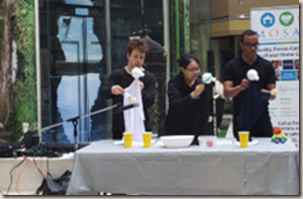
Then we switched back to lessons in English folk dancing:
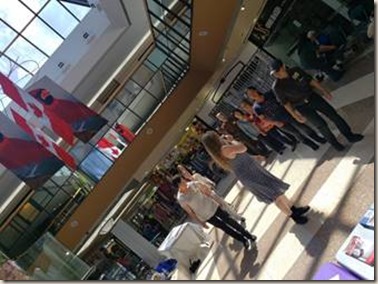
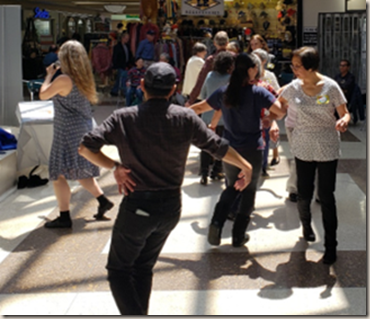

Third places in our communities
We would like to see more creative use of space in our communities.
Every square foot of our public space is a potential stage for communication, creativity and activity.
Developing these “third places” for natural community interaction is very important. Most of these spaces exist outside the institutional and health care realm and tend to be neglected when assessing community funding and grant decisions.
We urge our communities to look beyond the “doing to” deficit based model that has driven the institutional focus on community development hitherto towards an inclusive, active community based model that embraces all aspects and areas of our communities, our neighbourhoods, our businesses and our private individuals.
“Neighbours and Communities” group
A special thank you to members of Mosaic’s “Neighbours and Communities” group. The Neighbours and Communities group is a grassroots group looking at community engagement and voice at the community and neighbourhood level. The first few months of group has been spent looking at social networks, social capital, meaningful communication and the need for collaboration. It has also been introduced to the differences between asset based models of community development and the “doing to” model that tends to focus on peoples’ and communities’ deficits and weaknesses.
The group is looking at walkable neighbourhoods and after the summer break will be looking to reach out to local organisations, businesses and people to assess how we can all develop closer connection with community and support community building.

Marty and Miriam at the Neighbours and Communities Information Desk

Ramon and Regina at the event desk!
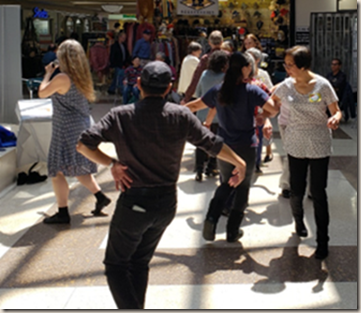 And Calvin, who appeared to be actively engaging with everyone….
And Calvin, who appeared to be actively engaging with everyone….
A simple plan to address social isolation
At Mosaic we have a simple plan to address social isolation. And because this last Saturday was also World Elder Abuse Awareness Day (WEAAD) our simple plan for community development also addresses one of the biggest risk factors for elder abuse, that of social isolation.
Our simple plan for reducing social isolation and community engagement is as follows:
A) Encouraging meaningful conversation and communication beyond the simple hello, how is the weather, how are you. Ask another question or two.
Recent research points out that people are actually more open and receptive to talking to strangers than you might think. But, let us not forget that we also often lack meaningful conversation with those we see day to day and that are close to us.
B) Develop socially supportive networks and culture in our walkable areas: these are our close neighbourhoods and our immediately walkable communities. Note that walkable may mean different things for different people and will vary according to how supportive our neighbourhood is.
C) Opportunities to engage in interests and activities that allow for a wide variety of interests and social needs. It is important that these opportunities do not frame participants as suffering from a deficit or a need but are considered as people who are able to contribute to community and its vitality.
D) An awareness of the importance of diversity, inclusivity and most importantly of empathy. Building a culture of empathy allows to take an interest in the realities of our joint existence and our rights to our own unique individuality within a social and community context. Our social interactions in public space should not exclude others, but should provide opportunity for connection with those important inner realms of being (social, personal and intimate space).
All of the above are dependent on the need for collaboration across our communities: individuals, private businesses, public sector and local governments, our environment and use of space. This is big picture, this is grass roots reaching out and connecting with our wider infrastructure, this is the development of voice, of awareness and empowerment and personal and community growth.
Let us move from the deficit, the bias, the need to the ability, the capability and potential of individuals and communities. We can have both the simple and the diverse experience, the engaged and the reflective solo moments.
What events are happening in your local area?
World Elder Abuse Awareness Day is June 15th. There are many events happening in and around your communities designed to engage people in awareness and prevention of financial, emotional, physical and sexual abuse of older adults specifically.
A good website for information can be found at Elder Abuse Ontario and we provide a copy of their Spring 2019 Newsletter for your information:



May 13, 2019 in
Community,
Mid town |
∞
“My knitting group has broken up,” said mom on the telephone, “but I may have found a new group to join. We got a flyer at the condo about a knitting group at the CNIB that’s open to the community.”
“You should go,” I said. “Winter is coming and you’ll need something to do. Besides what are we going to do with all the hats, mittens, and scarves we make every year?”
My mother, Katharina Duhatschek, lives in a condo at the Kilgour Estates, and for the past few years she has been meeting weekly in the condo library with a group of like-minded women to knit and crochet for charity. When I retired three years ago I got in on the fun, not showing up for meetings, but crocheting throughout the winter, making so many hats, scarves, and mittens that all family and friends were well-taken care of. I gave all my extras to mom’s knitting group which sent them to women’s shelters once a year.
I have long understood the therapeutic benefits of knitting and crocheting. Even before I retired I would often come home after a stressful day and crochet for hours into the evening, using the repetition of the stitches and the rhythm of the patterns, to calm me down. Plus I got a big kick out of making something, choosing colours and textures and patterns, and bringing them together into a finished product. It would be hard to get through a winter without knitting and crocheting.
“We’re making Twiddlemuffs” said mom on the phone. “Do you know what that is?”
“Nope. Never heard of them,” I answered. “But let me see the pattern and we’ll figure it out.” Mom had walked over to the CNIB the previous week and met the wonderful women of Mosaic. Mosaic, we learned, is a home care and community resource centre. The knitting and crochet group was making muffs, decorated on the inside and out with buttons, flowers, elastics, and ornaments. The muffs would be distributed to residents of the Sunnybrook Health Sciences Centres Veteran’s Wing. Not only do the muffs keep fingers warm, but they keep fingers busy.
“They’re doing decoupage,” said mom on the phone a few months later. “Do you know what that is?”
“I think so I said. You stick pictures on wood and then varnish it. You should go.”
The next time I visited, mom proudly showed me her decoupage box. She had painted the exterior of the wooden box in blue and then cut out shapes of cottage scenes, black bears, canoes, and pine trees. “I think I’ll take it to the cottage this summer and put all our cottage photos in it. I’ll leave it on the coffee table so people can look through the pictures.”
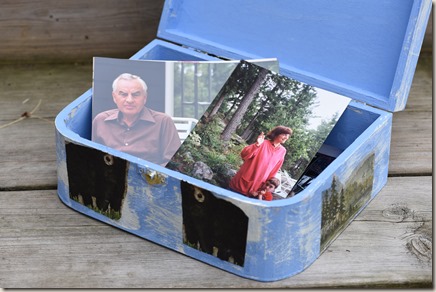
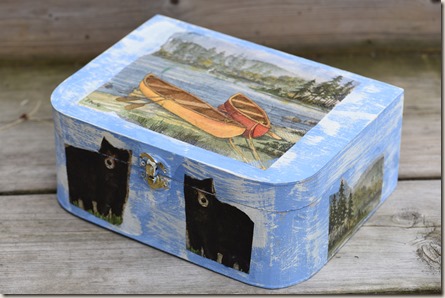
Creativity is important to well-being, and while we all encourage creativity in children, sometimes we forget that we still need to be creative as a we get older. Making things, whether it’s boxes, or mittens, or muffs, allows us to design and innovate, to express ourselves through our hands, to produce something and be proud of it. I’m glad mom has found a group like Mosaic, where she can participate in a creative community.
By Monica Duhatschek
Tags: Knitting

March 4, 2019 in
Social Work |
∞
Every year in March, Canadians acknowledge the important work provided by Social Workers with Social Work Week. This year, the theme is “From everyday issues to complex needs: Social Workers, it’s what we do” and is being held the week of March 4-10, 2019.
The primary role of a Social Worker is to help people resolve their problems or challenges that are affecting their daily lives. They help identify what is causing the challenge or stress, and work with the individual to develop coping strategies. Often, this involves connecting the person/family to organizations in the area where they live.
Social Workers (about 17,000 in Ontario!) can be found in hospitals, family agencies, mental health settings, schools, and Employee Assistance Programs, to name a few. They are truly the ‘system navigators’ helping to connect those who may have entered the health care system and need help finding out who does what.
Examples where a Social Worker might help: mediating families in a crisis such as: an unexpected illness, grief counselling and elder care. Suicide prevention, mental health counselling, bullying and abuse and the stresses that people live with are all situations where Social Workers can help.
As our society ages and the number of socially vulnerable adults with complex care needs grow, the conflict between available resources – finances, people, time – will also grow, with more and more individuals seeking help from Social Workers.
It is unimaginable for most of us to think of what a ‘day in the life of a social worker’ would look like working with individuals and families who are in crisis, day in and day out. Take a few minutes to think about this. It’s not an easy job and it takes a special person to be a Social Worker. Be thankful that there are those who choose this career path because they want to help others. And they do a wonderful job!
At Mosaic, most of our clients are older and have complex care needs, so we work with Geriatric Care Managers, who are often Social Workers. We also work with Social Workers in hospitals when a patient is about to be discharged. And we have our very own Social Worker, Sarah, who is an important part of our team.
Mosaic staff will be visiting social workers at hospitals during March with food and treats as our way to say thank you to them. If you know a social worker, please take the time to acknowledge them!
If you are looking for a Social Worker who can help with an elderly parent or friend, please call Mosaic and we can refer you to a number of Geriatric Care Managers. Or, if you are looking for programs or organizations that have a Social Worker on site, our Community Resource Centres can help you with this. Call us at 905.597.7000 or 416.322.7002 or visit our website for more information: www.mosaichomecare.com
For more information about Social Workers, please visit their website: www.oasw.org
THANK YOU TO ALL THE SOCIAL WORKERS WHO WORK TIRELESSLY TO HELP OTHERS!
February 14, 2019 in
Uncategorized |
∞
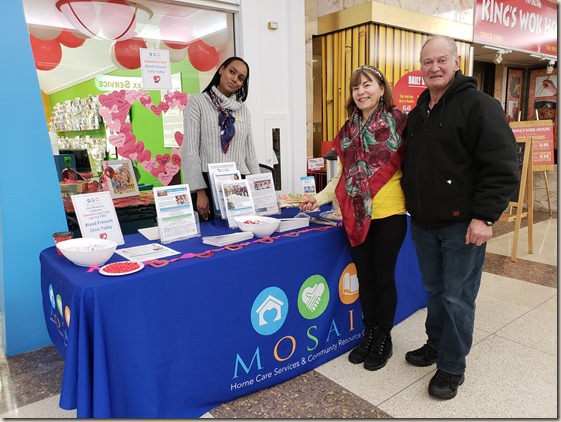
Beth Eshete and members of our community on Valentine’s Day 14 February 2019
|
Every year, seemingly the day after New Year’s, the advertising starts for Valentine’s Day. Red hearts in store windows, media advertising diamond jewellery to show how much ‘you love a person’, and of course, chocolate. Let me say right now, I LOVE chocolate. Seriously.
In the coldest month of the year, we have the excuse to get cozy with one another and celebrate love. But what does Love mean? If you asked 10 different people, you would get 10 different answers. Of course, there would be some overlap, but each person has their own love story. What is yours?
Would Chapter One be about the pet you had as a young child or about a sibling you looked up to? Maybe Chapter Two would be about your first love when you were only 8 years old? What chapters would your first kiss, your first break-up/make-up and your first ‘I Love you’ fall in to? Weddings, children and family pets. So much love! An entire lifetime could be put in to Chapters for sharing.
We now celebrate Family Day in February. It’s a great way to spend some time together and perhaps watch a movie or read excerpts from a book. So many options to choose from be they classic or modern. Remember these? 101 Dalmatians, The Bridges of Madison County, The Notebook, Titanic, Casablanca, The English Patient, The Time Traveler’s Wife, Happy Feet, and who can forget Romeo & Juliet or Pride and Prejudice? And these are just a few…
If music is more your thing, perhaps update your playlist to include some of the old favourites just to play on Valentine’s Day: Endless Love (Diana Ross); You Can’t Hurry Love (Supremes); Because You Love Me (Celine Dion); I Think I Love You (Partridge Family); Crazy in Love (Beyonce); and I Will Always Love You (Whitney Houston). If you like Country Music, pretty much every song has to do with being in love or falling out of love or breaking up then making up.
Oh, the ups and downs of love.
A mother’s love; a spouse’s love; siblings and furry friends; friends. Love is action. Perhaps you show this by a hug when one is needed (and even when it’s not); listening; supporting even when you may not agree with a situation. Cooking for your friends and family. Showing concern for another being – human or animal. It is affection without expectation and is unconditional. This doesn’t mean it can’t get loud and annoying at times. Because we know it does. But love should always be respectful, even in times of strife.
So, celebrate love. Grab a good love story, a box of chocolates and kleenex and your family or best friend and spend some time together. Talk about your own love story. Or come to Mosaic for our Community Café and share your story with others. Call us for more information or visit our website for program descriptions and dates.
Written by: Dina Campeis; Community Relations Manager, Mosaic Home Care & Community Resource Centres. (416.322.7002 or 905.597.7000. www.mosaichomecare.com
Tags: Valentine's Day
February 11, 2019 in
Community,
Mapping |
∞



![clip_image002[5] clip_image002[5]](https://janesgtacafe.ca/wp-content/uploads/2019/07/clip_image0025_thumb.png)

![clip_image002[9] clip_image002[9]](https://janesgtacafe.ca/wp-content/uploads/2019/07/clip_image0029_thumb.png)


























